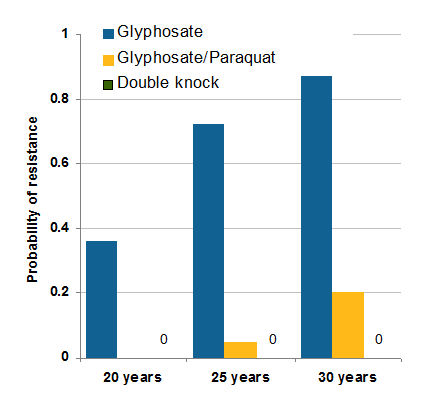 Australian farmers are using a Double Knock including paraquat
Australian researchers have found that spraying paraquat in a ‘Double Knock’ system is a very effective way to restrict the evolution of glyphosate resistant weeds. Survivors of glyphosate burndown are sprayed with paraquat up to two weeks later. The Double Knock ensures that weeds are hit with two different modes of action.
Australian farmers are using a Double Knock including paraquat
Australian researchers have found that spraying paraquat in a ‘Double Knock’ system is a very effective way to restrict the evolution of glyphosate resistant weeds. Survivors of glyphosate burndown are sprayed with paraquat up to two weeks later. The Double Knock ensures that weeds are hit with two different modes of action.
The system works best when glyphosate is given a little time to translocate through weeds to the roots; when paraquat is applied while weeds are still green; and when early rains encourage a new flush of germination.1
Researchers at WAHRI (Western Australian Herbicide Research Initiative) calculated that after 20 years’ annual use of glyphosate in an arable rotation, more than one field in three with an annual ryegrass problem would be expected to have a weed population resistant to glyphosate.1
 Calculated probability of glyphosate resistant ryegrass evolving
The chart opposite also shows that the simulation calculated that if the herbicide used in land preparation was alternated between glyphosate and paraquat, only one field in five would be expected to have resistance after 30 years, compared to nearly 90% of fields sprayed only with glyphosate. A ‘Double Knock’ regime with paraquat cleaning-up after glyphosate was predicted to keep all fields free of glyphosate resistant ryegrass for at least 30 years.3
Calculated probability of glyphosate resistant ryegrass evolving
The chart opposite also shows that the simulation calculated that if the herbicide used in land preparation was alternated between glyphosate and paraquat, only one field in five would be expected to have resistance after 30 years, compared to nearly 90% of fields sprayed only with glyphosate. A ‘Double Knock’ regime with paraquat cleaning-up after glyphosate was predicted to keep all fields free of glyphosate resistant ryegrass for at least 30 years.3
Other important Australian weeds that are hard to control with glyphosate are also being tackled by a paraquat Double Knock approach.
Conyza bonariensis (flaxleaf fleabane) is a major weed problem in S. Queensland and N. New South Wales, in particular.4,5,6 It is a prolific seeder, emerging in different seasons. One plant can produce 100,000 airborne seeds and it is imperative to prevent any survivors from weed control from setting seed. Seeds germinate at or near the soil surface, so, unfortunately, it is encouraged by no-till or other conservation tillage methods. Another issue is that the weed is quite tolerant of glyphosate. Although no official cases of actual glyphosate resistance have been recognised yet in Australia, several other countries have resistance2, so it is important to fight this threat. The standard treatment is to attempt to control young weeds with a mix of glyphosate and 2,4-D. Recent field trials have shown that this resulted in only 67% control. However, when paraquat or the mixture of paraquat and diquat popular with Australian farmers was sprayed 5 – 7 days afterwards to give the ‘Double Knock’, control levels were raised to over 95%.
References
- WAHRI newsletter, Autumn 2010.
- International Survey of Herbicide Resistant Weeds
- Neve, P, Diggle, A J, Smith, F P and Powles, S B (2003). Simulating evolution of glyphosate resistance. II. Past, present and future use glyphosate use in Australian cropping. Weed Research, 43, 418 - 427.
- Werth, J, Walker S, Boucher, L & Robinson, G (2010). Applying the double knock technique to control Conyza bonariensis. Weed Biology and Management, 10, (1), 1-8.
- Walker, S, Widderick, M & Cook, A (2010). Spraying young flaxleaf fleabane is the key for best control. Australian Grain, March – April 2010, 4–6.
- Queensland Department of Employment Economic Development and Innovation (Primary Industries). Flaxleaf fleabane
Notes
The brand name of the leading paraquat product is GRAMOXONE® and the leading paraquat + diquat mixture in Australia is SPRAY.SEED™ 250 HERBICIDE .

